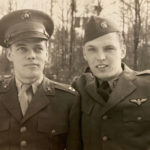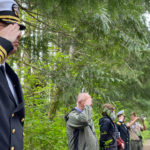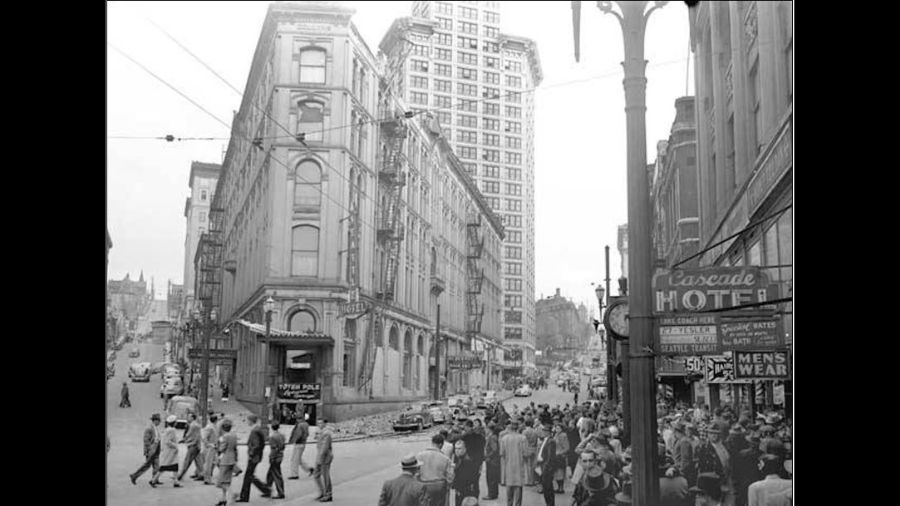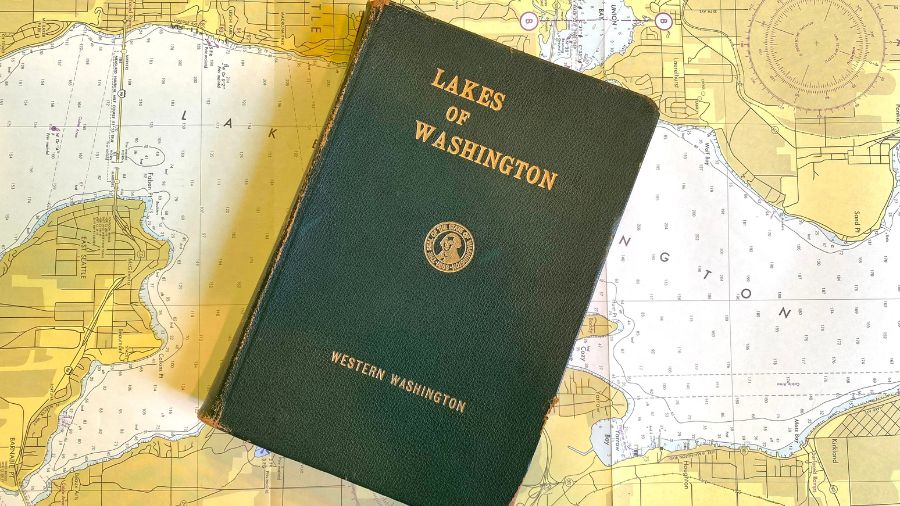Monument in Cascade foothills honors long-missing aviators
May 31, 2023, 11:03 AM | Updated: 11:37 am
It’s not quite the final chapter, but the story of two lost Navy aviators reached a significant milestone just in time for Memorial Day.
A special private ceremony took place last Saturday. It was held in the foothills of the Cascades east of Carnation, more than 10 miles down a private logging road at a place called Black Lake.
The occasion was the dedication of a monument – a huge boulder, engraved with the names of the two men: 23-year old Ensign Gaston Mayes, and 25-year old Lieutenant, junior grade, Benjamin Vreeland. The pair took off one day, 72 years ago, in an SNJ-5 trainer, a World War II-era, single-engine Navy plane. They left from the old Sand Point Naval Air Station in Seattle — what’s now Magnuson Park – for what should have been a two-hour flight.
They were never seen again.
The loss of the two flyers was a tragedy for the families of both that took its toll over many years, but Saturday’s event felt more like a celebration for the 20 or so people who attended.
Unveiling and dedication of monument to lost Navy aviators in the Cascade foothills at Black Lake.
Full story Wednesday morning @KIRORadio 6:15am and 8:35 am; web version at @Mynorthwest pic.twitter.com/153nmCZAdc
— Feliks Banel (@FeliksBanel) May 26, 2021
Two of the people there were Lee Corbin and Shawn Murphy, both retired, and both aviation and history enthusiasts. It’s their research and other legwork that helped convince the U.S. Navy to officially conclude last October – more than 70 years after it was lost — that the SNJ-5 and the two men likely ended up in Black Lake.
Along with Lee, Shawn, and the others, there was also a very special guest.
Dan Vreeland lives in Austin, Texas. He’s the nephew of one of the lost flyers. Lt. Benjamin Vreeland was the brother of Dan Vreeland’s dad – the “Uncle Benny” that Dan was too young to have ever met.
The ceremony was organized and led by Michael Pollina of American Legion Post Number 79 in Snoqualmie, and it was the members of Post 79 who paid $8,000 of the Post’s funds to create the monument and have it installed at the lake. Along with volunteers, other guests included a commander from NAS Whidbey Island, and Lourdes E. ‘Alfie’ Alvarado-Ramos, director of the Washington State Department of Veterans Affairs.
One of the speakers was Lee Corbin, who also happens to be a retired military and commercial pilot.
“These two guys took off from Sand Point Naval Air Station on March 11 of ’49, at about 10:05 in the morning,” Corbin told the audience, who stood on a dirt road running along the edge of the lake. “They came out here, came out east, to just basically build some flying time and maybe have a little fun.”
But the fun didn’t last.
“[The plane] had some engine problems, and they ended up coming around the back side of this mountain right here,” Corbin continued, turning his back to the audience and motioning with his left arm across the broad expanse of water that lay behind a line of trees between the road and the shore.
“They had their engine out, and were going to land on the water,” Corbin continued, as he recounted a theory about the lost plane that dated to the 1950s. “And unfortunately, they either ran out of air speed or, we also feel, they might have hit some trees.”
“It just did not end well for them,” Corbin said.
Several other guests gave short but emotional speeches, including Dan Vreeland. Vreeland was effusive in his gratitude and praise, especially for Corbin and Murphy, and he seemed genuinely surprised by all the attention and effort.
“It’s hard to fathom that so many people would show an interest in an obscure little piece of history,” Vreeland said, clearly moved by the experience.
He also described how Corbin and Murphy had solved a longstanding family mystery.
“[Ben] told my father that he had a surprise for him come Easter, when they came on leave when he was coming back from Seattle, back to New Jersey,” Vreeland said, recalling family events from before he was born. “And my father never found out what the secret was, and thanks to research done by Lee and Shawn, we found out that my uncle had signed up for legal classes with the Navy.”
“My father was a lawyer, and I’m sure [my uncle’s] plan was to become part of my father’s law group,” Vreeland said.
After the brief ceremony concluded with a prayer and then an Eagle Scout playing “Taps” on a bugle, Murphy and Corbin led Dan down to the edge of Black Lake. Shawn put his hand on Dan’s shoulder, described the most recent search, and pointed out how the plane had likely ended up in the lake.
“The anomalies were right here, right off there, right down there in about the middle and then down over towards the edge over there,” Murphy said, pointing toward the center of the narrow lake.
“With the magnetometer, that’s what the hits were,” Murphy continued, naming the piece of equipment commonly used to locate sunken ships and planes.
“It would have been coming in that way from there,” he pointed out, gesturing across the oblong lake and describing the possible path of the SNJ-5. “They would have probably tried to center up on the lake. If they topped the trees, as we think they did” – meaning if they hit the tops of the trees, as evidence seemed to indicate in the 1950s – “it means that [the plane] would have hit like this” – Murphy was now motioning with his hands – “so [the plane] would have either been in a stall, or he was banking to it.”
“And once he hit those trees,” Murphy concluded, “I think he cartwheeled in.”
The 2020 search, and earlier searches 60 years ago, were stymied by a thick layer of mud on the bottom of Black Lake. It may be as much as five or six feet thick – or even deeper than that – and it swallows up anything that sinks to the bottom.
Where the bottom of many Cascade lakes are littered with visible snags, tree trunks, and other debris, in Black Lake, the bottom is smooth and featureless, says Scott Williams, a maritime archaeologist who assisted with the project. Add to this the fact that the SNJ-5 may have broken up on impact, and the odds of finding evidence of the plane only get longer.
Back in Texas, Dan Vreeland works as an electrician. As the only family member in attendance, he was the one person there on Saturday for whom the long-ago deadly event at Black Lake was deeply personal. He even brought some of his late father’s ashes with him. While a small group looked on, Dan placed those ashes in Black Lake – reuniting two brothers – just steps from where Shawn Murphy had described the search and the likely circumstances of the crash.
Dan says it was important to him – and to his mother – that Dan’s father, Theodore “Ted” Vreeland, be reunited with his long-lost brother Benjamin.
“I feel like I was on a mission coming up here to do this, to be here for this,” Vreeland said, pointing to ashes that were still visible as they swirled in the dark lake water. “I definitely wanted to be here for this, and to bring my father, a little bit of my father, and I guess I’m a little bit of my father, too,” he said, chuckling.
As he stood at the lake’s edge, having just scattered his father’s ashes into the water, Vreeland noted the tone and tenor of the gathering.
“It’s a celebration more than a memorial,” Vreeland said, smiling. “It’s celebrating a lot of work and a culmination to come to this point. And it’s also the beginning of possible more searches and maybe finding the wreckage.”
But, even without further searches of Black Lake, Dan Vreeland is confident that the plane and Ensign Mayes and his Uncle Benny are where Lee Corbin and Shawn Murphy – and now the U.S. Navy – say that they are.
“I don’t need a tangible piece to know that he’s here,” Vreeland said. “I mean, I 100% know he’s here.”
Shawn Murphy lost a family member in World War II. Pat Murphy, his uncle, is listed on the Memorial Wall at Memorial Stadium at Seattle Center.
The younger Murphy knew he was uniquely qualified, and maybe even obliged, to help the families of the two SNJ-5 aviators.
“My uncle, [it] was known where he died [and] where he was buried,” Murphy said on Saturday. “And in this case, these are families that never got full closure. Even though they knew [the two aviators] were dead, they didn’t know, with full closure, exactly where they were.”
Murphy, who has experience with a previous maritime heritage project involving a sunken vessel, was first introduced to Lee Corbin a few years ago through KIRO Radio. Lee had been researching Mayes’ and Vreeland’s lost plane for several years, and had been in contact with family members and others as he put together a voluminous file of information and published an article in an historical journal.
With Murphy’s help – and help from Murphy’s diver friends – they launched a new search of Black Lake in early 2020.
“These guys are divers that are here [today], they helped me out [by searching Black Lake],” said Shawn Murphy. “That’s really what it was about – my own history love and study of history – and then being able to give people some answers.”
Lee Corbin’s nearly decade of research on the lost plane was critical in making Saturday’s event possible. In that research, what first captured Lee Corbin’s imagination was Nora Mayes — the mother of Ensign Gaston Mayes.
Gaston Mayes was from Tennessee, and that’s where his mother Nora Mayes was living when Gaston disappeared. But she came to Washington to be nearby during the search, and she kept coming back every summer for nearly 20 years. By conducting her own investigation, Nora Mayes figured out more than 60 years ago that her son’s plane was likely in Black Lake, and she even had divers searching there in the late 1950s and early 1960s.
She never gave up, Lee Corbin says, trying to find her son.
“Nora Mayes was the primary person, she came out here every summer,” said Lee Corbin during the ceremony. “Once the snows were melted, she would just search these hills and she just never gave up. She finally figured this is where they were, and she just kept looking and looking and looking, [but] never got the closure that that she wanted.”
One more key figure in the search for Mayes and Vreeland is maritime archaeologist Scott Williams. He wrote the report, based on Corbin and Murphy’s research, that was submitted to the Naval History & Heritage Command last year that led to the formal recognition of Black Lake.
Last October, Dr. George Schwarz, an underwater archaeologist with the Naval History & Heritage Command, told KIRO Radio that the scope and scale of the Corbin-Murphy-Williams effort to locate the lost plane was somewhat unusual.
“It’s not uncommon to get information like this, but it’s less common to have researchers that are dedicated over an extended period of time to gather all of these different sources of information to really flesh out the history of an aircraft,” Dr. Schwarz said.
“We do appreciate dedicated researchers like this because it is helpful to our mission [to locate missing aircraft],” Dr. Schwarz continued. “There are tens of thousands of sunken military craft around the world, and so when we have these types of researchers that are putting this kind of effort to help solve some of these cases and help us account for these sites, it’s very much appreciated.”
It’s clear that Dan Vreeland also appreciates what Lee, Shawn, Scott and all the volunteers did to reach a point where a permanent monument could be dedicated at Black Lake in his uncle’s memory.
As he stood before the boulder and traced his uncle’s name where it was carved into the stone, Dan Vreeland read the words aloud.
“In honor of Lieutenant, jg, Benjamin Oliver Vreeland, 25, of Bridgeton, New Jersey and Ensign Gaston Eugene Mayes, 23, of Clinton, Tennessee. Departed Sand Point Naval Air Station, Seattle, March 11, 1949. Here they rest in these beautiful environs. Dedicated by American Legion Post 79, Snoqualmie, Washington,” Vreeland read.
“It’s really kind of nice having something to physically look at, a reminder to see and touch,” Vreeland noted.
Is there such a thing as closure?
“Nah,” Vreeland said. “There’s acceptance, but nothing ever really closes. I mean, there’s still more work to be done” – meaning more possible searches of Black Lake, and more mysteries to be solved – “so we’ll see what happens.”
To contribute to American Legion Post 79 in support of the monument at Black Lake – which is not accessible by the public – as well as a similar smaller monument that will be installed at the Post in Snoqualmie, please click here.
You can hear Feliks every Wednesday and Friday morning on Seattle’s Morning News, read more from him here, and subscribe to The Resident Historian Podcast here. If you have a story idea, please email Feliks here.



























